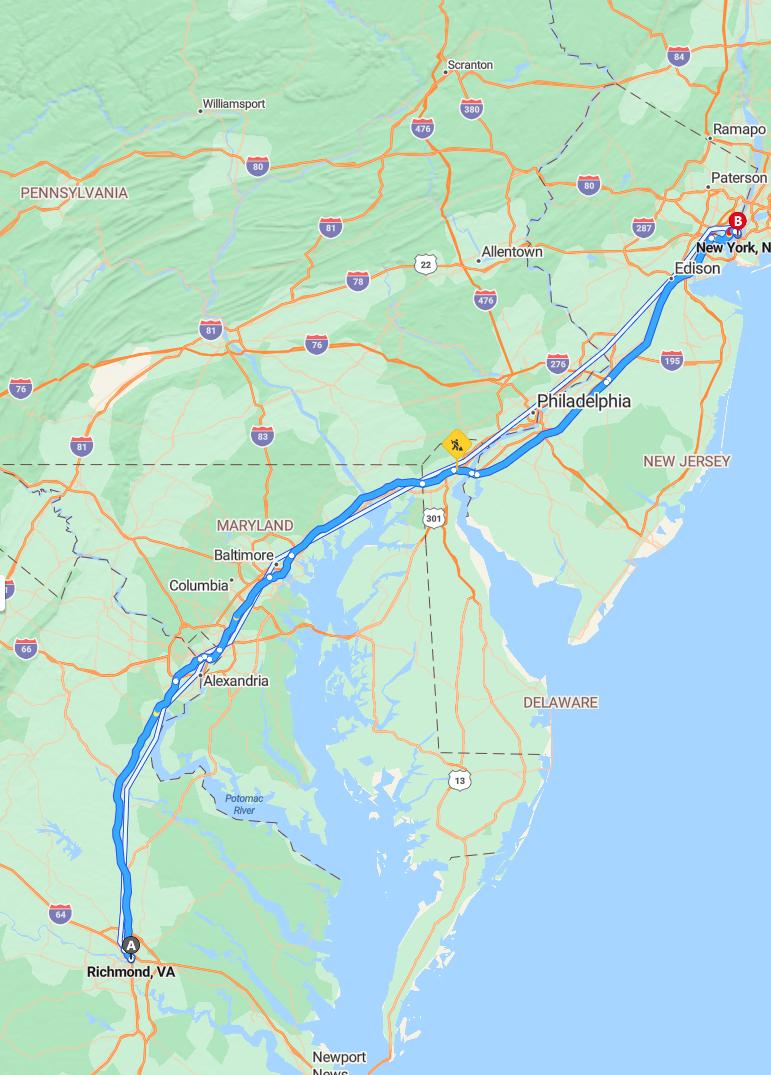Distance and estimated driving time
A road trip from Richmond to New York covers approximately 333 miles, primarily traveling along I-95 North and the New Jersey Turnpike. The estimated driving time is around 5 hours and 24 minutes, depending on traffic conditions. This route offers a direct and efficient way to reach New York City, passing through key states like Virginia, Delaware, and New Jersey. To ensure a smooth journey, consider checking real-time traffic updates and potential toll information along the route.
Driving route
Driving from Richmond to New York offers a scenic and efficient route through several key cities on the East Coast. Starting in Richmond, Virginia, travelers head northward, passing through the historic city of Baltimore, Maryland, known for its harbor and vibrant neighborhoods. Continuing the journey, the route advances to Philadelphia, Pennsylvania, home to iconic landmarks such as Independence Hall and the Liberty Bell. Finally, the trip concludes in New York City, a bustling metropolis famed for its cultural diversity, skyline, and entertainment options. This route combines urban exploration with scenic vistas, making it an engaging drive through some of the most significant cities in the United States.

Best departure times for avoiding traffic
To minimize traffic congestion when driving from Richmond to New York, it is best to depart early in the morning, ideally before 7 a.m., as this time generally avoids peak rush hour in Richmond and along major highways. Traveling during mid-morning or early afternoon can also help you avoid the heavier traffic typically seen during late afternoon and evening, especially around Baltimore and Philadelphia. Planning your departure on weekends or during off-peak hours on weekdays can further reduce delays, as these times tend to have lighter traffic flow. Ultimately, checking real-time traffic updates before your trip will help you choose the optimal departure time to ensure a smoother journey.
Fuel efficiency tips for the trip
To maximize fuel efficiency on your trip from Richmond to New York, plan your route to avoid heavy traffic and sudden stops, which can increase fuel consumption. Maintain steady speeds by using cruise control when possible, and ensure your vehicle is well-maintained with properly inflated tires and clean air filters. Lighten your load by removing unnecessary items from your car, and consider minimizing air conditioning use to reduce engine strain. Finally, combining errands and planning your stops efficiently can help you conserve fuel and enjoy a smoother, more economical journey.
Road conditions and potential hazards
Driving from Richmond to New York, travelers should be prepared for varying road conditions and potential hazards along the route. Major highways, such as I-95, generally offer well-maintained roads, but seasonal weather changes can lead to slick surfaces or reduced visibility, especially during winter months. Construction zones and traffic congestion in urban areas like Baltimore and Philadelphia can cause delays and require cautious driving. Additionally, sudden lane shifts, merging traffic, and pedestrian activity in city centers pose further hazards, so drivers should remain attentive and adapt their speed accordingly.
Recommended rest stops and amenities
When driving from Richmond to New York, it is advisable to plan rest stops at key locations such as Baltimore and Philadelphia, where ample amenities are available. In Baltimore, travelers can enjoy well-equipped rest areas offering clean restrooms, food options, and parking facilities, making it convenient to refuel both vehicle and energy levels. Philadelphia provides numerous services, including truck stops and convenience stores, ideal for taking a break and grabbing refreshments. Once in New York, drivers can find rest areas with modern amenities, ensuring a comfortable and safe journey throughout the trip.
Toll information and payment options
When driving from Richmond to New York, travelers will encounter various tolls along the route, especially near Baltimore, Philadelphia, and into New York City. These tolls can be paid using electronic toll transponders such as E-ZPass, which is widely accepted across the interstate highway system and offers convenient, cashless payment options. For those without a transponder, tolls can often be paid manually at booths with cash or credit card; however, some areas might only accept electronic payments. It is advisable to carry sufficient cash or ensure your E-ZPass account is funded beforehand to avoid delays and ensure a smooth journey through the toll zones.
Weather forecast along the route
Travelers driving from Richmond to New York can expect varying weather conditions along their route. In Richmond, Virginia, mild temperatures with occasional light rain are forecasted, making for a relatively comfortable drive. As you approach Baltimore, Maryland, the weather may become slightly more unsettled, with chances of scattered showers and cloudy skies. Moving into Philadelphia, Pennsylvania, drivers might encounter cooler temperatures and intermittent rain, while in New York City, conditions should stabilize with partly cloudy skies and mild temperatures, providing a manageable journey overall.
Vehicle maintenance checks before departure
Before departing from Richmond to New York, it is essential to perform comprehensive vehicle maintenance checks to ensure a safe and smooth journey. This includes inspecting tire pressure and tread for optimal traction, checking fluid levels such as oil, coolant, and brake fluid, and ensuring all lights and signals are functioning properly. Additionally, examining the brakes, windshield wipers, and verifying that the battery is in good condition can prevent unexpected breakdowns. Conducting these pre-trip assessments helps to mitigate potential hazards and guarantees a comfortable drive through Baltimore, Philadelphia, and ultimately to New York City.
Local laws and driving regulations
When driving from Richmond to New York, it is important to be aware of the varying local laws and driving regulations across these states. Virginia requires drivers to adhere to its speed limits and observe rules regarding seat belts and mobile device use, while Maryland enforces strict DUI laws and roadside safety inspections. Pennsylvania has specific regulations on lane usage and tailgating, and New York maintains rigorous standards for insurance, licensing, and traffic violations. Familiarizing yourself with each state's driving laws ensures a safe journey and helps avoid potential fines or legal issues while traveling through multiple jurisdictions.
